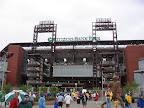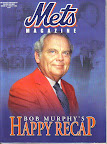May 31, 2004
Mets 5, Phillies 3
W: Orber Moreno
L: Brett Myers
S: Braden Looper
HR: Jason Phillips (NYM), Pat Burrell (PHI)
Attendance: 43,620
Time of Game: 3 hours, 2 minutes
Stadium Facts
Location: Philadelphia, PA
First Game: April 12, 2004
Capacity: 43,500
Type: Open
Surface: Grass
My summer baseball trip of 2004 took me back to familiar territory: the Midwest. However, a month prior to my main trip of the summer, I knocked out the first new ballpark of the year on Memorial Day in Philadelphia. I was in Philadelphia for a friend's party and went to the Phillies game the following afternoon with a bunch of people. I had done the same thing the previous Memorial Day when I saw my first and only game at Veterans Stadium. However, I didn't bother counting that as an official stop on my stadium tour since I knew I would be returning for a game at the brand new Citizens Bank Park the following summer.
As has been the case for most Memorial Day weekends since I moved out east, the weather didn't exactly cooperate on this day. There was rain throughout the afternoon, including prior to the game. A pre-game rain delay pushed the start back more than an hour. On a positive note, this gave me more time to explore the new park.
Citizens Bank Park is a huge improvement over Veterans Stadium. It is an outstanding ballpark in the South Philly sports complex. The complex includes Lincoln Financial Field (Eagles), Wachovia Center (76ers, Flyers, Villanova) and the old Spectrum. The Vet was also in this area. So all of Philly's professional teams play within a couple blocks of one another, unlike any other four sport city in the country. The location is pretty good too: easily accessible from major highways and not too far from downtown Philly.
I really like the design of Citizens Bank Park. There are great seats throughout the park. There are plenty of lower level seats in the outfield and a neat second level in left field below the large scoreboard. There are three levels surrounding most of the field, including right field, creating a little more of an intimate feel than a few of the other similar parks. The concourses are another strong point of the park.
There are plenty of other places to watch the game if you don't like your seats. There is a popular standing room area above the bullpens in center field, which is ideal for hecklers... and in Philadelphia there are no shortage of those. You just don't know for sure if they will heckle the visitors or their own Phillies.
Our seats were in the second level in left field. These would have been pretty nice seats on a normal day, but not so great in the rain. If you need proof of our inability to avoid the raindrops, just see the cover of my program below which was exposed to the elements. Later in the game, we moved to dryer grounds on the concourse during the second rain delay and the later stages of the game. Some of our friends were lucky enough to move down behind the Mets dugout after the delay, but I did not.
After the pre-game rain delay, the game finally started with Brett Myers on the mound for the Phillies. Cliff Floyd put the Mets on the board early with an RBI double in the top of the first. Matt Ginter pitched three scoreless innings for the Mets, but would not figure in the final outcome due to the second rain delay. After the third, the umpires called for the delay. It took the grounds crew a considerable amount of time to get the tarp over the infield in the pouring rain.
Two and a half hours later, the game resumed with the Mets ahead 1-0. Obviously, the new park has a great drainage system, because it appeared for a while that the game might have to be postponed. The crowd thinned out considerably during the lengthy delay, but we stuck it out.
Jason Phillips promptly hit a home run for the Mets in the top of the fourth to make it 2-0. A Todd Zeile double in the fifth made it 3-0, before the Phillies finally got on the board in the bottom half. Chase Utley reached base to lead off the bottom half as his grounder went threw the legs of catcher, turned first baseman, Mike Piazza. After the Phillies loaded the bases, a base hit by David Bell cut the Mets lead to 3-2.
The Mets got back to work in the top of the eighth. A two run double by Mike Cameron gave the Mets a commanding 5-2 lead. Pat Burrell hit a home run in the bottom half, his second home run on my ballpark tour. However, the Mets hung on for a 5-3 victory. Orber Moreno picked up his first major league win in relief. Braden Looper pitched a scoreless ninth inning to record the save.
This was a rematch of the Phillies/Mets matchup I saw in Shea Stadium the previous year, with the visiting team winning each game. Much like 2003, this season was much better for the Phillies than the Mets, however the Braves once again won the National League East. This game was early enough in the season where both teams were very much in the hunt. It probably would have been an intense crowd for this rivalry game, but the rain delays put a damper on things (pun intended). By the end of the game, there couldn't have been more than a few thousand of us remaining, despite the game being a sellout.
It was unfortunate that the weather did not cooperate, but it did not hurt my opinion of the ballpark. Citizens Bank Park is definitely in the upper echelon of stadiums. Probably better than Philadelphia deserves (just kidding... sort of). Surprisingly, I haven't made it back to another game since this one. I'm sure I will go there again soon though since its a pretty easy trip up I-95.
Photo Album
 |
| From Philadelphia |
 |
| From Philadelphia |
 |
| From Philadelphia |
 |
| From Philadelphia |
 |
| From Philadelphia |
.JPG) |
| From Philadelphia |
.JPG) |
| From Philadelphia |
Next stadium: Busch Stadium, St. Louis

















.JPG)
.JPG)






.JPG)
.JPG)










.JPG)
.JPG)